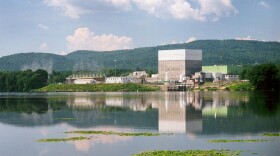Radioactive tritium-contaminated water has leaked into the groundwater at the Indian Point nuclear power plant. New York’s governor over the weekend ordered two state department heads to investigate. Indian Point officials say the leak was contained and there is no risk to public safety.
The tritium leak into the groundwater at the Indian Point Energy Center in Buchanan became public over the weekend. Officials from Indian Point parent Entergy say the contamination has remained contained to the site and there's no risk to the public. They say recent samples from their groundwater monitoring program identified elevated levels of tritium — a radioactively weak isotope of hydrogen — in three monitoring wells out of several dozen. Nuclear Regulatory Commission spokesman Neil Sheehan says Entergy notified the NRC February 5 of the well spike based on the result of samples taken January 26.
“The NRC will be sending a specialist in the area of radiation protection to the plant this week who will be assisted by our onsite inspectors,” says Sheehan. “We have three full-time inspectors based at Indian Point.”
Sheehan says the specialist inspector’s task will be to learn why the sump pump failed, what happened during the overflow, and:
“How the water was able to make its way out of the Unit 2 spent fuel pool building basement into the groundwater and then result in some groundwater monitoring wells showing a spike in tritium,” Sheehan says. “This is not a new at issue at Indian Point in terms of groundwater contamination. They’ve had some issues in the past there, including leakage from the Unit 2 spent fuel pool building.”
In a statement on its web site, Entergy says the tritium did not affect any source of drinking water onsite or offsite. The NRC’s Sheehan adds it likely will make its way to the Hudson River.
“As with groundwater contamination there that’s been discovered in the past, that water will flow down through the fractured bedrock and make its way to the river,” Sheehan says.
Still, he says the millions of gallons of water flowing by constantly in the river would render the tritium virtually undetectable. Calling the latest failure at Indian Point unacceptable, Governor Andrew Cuomo directed acting commissioner of the Department of Environmental Conservation Basil Seggos and Department of Health commissioner Howard Zucker to investigate the incident. He asked that they work with the NRC to determine the extent of the release, its likely duration, cause and potential impacts to the environment and public health. Seggos formerly was an attorney with environmental group Riverkeeper, which wants Indian Point shut down. Paul Gallay is president of Westchester County-based Riverkeeper.
“This latest incident at Indian Point is further proof that the plant is just too old, it’s been through too much. In the last seven months, you’ve had seven different major malfunctions – pump failures, transformer explosions, radiation leaks, power failures, fires, oils spills,” says Gallay. “At some point, you just say to yourself, will the next malfunction be the one that causes major damage. And you just can’t take that risk.”
Entergy officials did not respond to calls for investigations beyond the statement on the web. Of the three wells, one’s radioactivity increased nearly 65,000 percent. Again, the NRC’s Sheehan.
“They did see a spike of the tritium levels in one of the monitoring wells closest to the Unit 2 spent fuel pool building that would have been on the order of 8 million, which is the highest level to date,” Sheehan says.
The 8 million figure he mentions refers to liters. U.S. Senator Charles Schumer is calling for the NRC to order an investigation immediately to determine the extent of groundwater contamination and why the sump pump failed. He says more must be done to prevent leaks in the first place. The NRC’s Sheehan says the specialist inspector being sent this week will determine if further investigation is necessary.
The license for Indian Point 2 expired in September 2013, and for Indian Point 3, in December 2015. The relicensing process for both is ongoing, and the NRC’s Sheehan responds to whether the tritium leak will be a factor.
“This is not something that we would expect to really fall into the license renewal review space,” says Sheehan. “However, whether one of the groups involved or the states involved in the hearing would try to raise it as an issue, that remains to be seen.”
Meanwhile, tritium leaks were also an issue in 2010 at the Vermont Yankee Nuclear Power Plant. The radioactive water was found in monitoring wells. Investigations found multiple leaks allowing contaminated groundwater to move toward the Connecticut River. Entergy confirmed during the investigation that tritium had also leaked from the site in 2005. Entergy shut down the reactor in December 2014.






